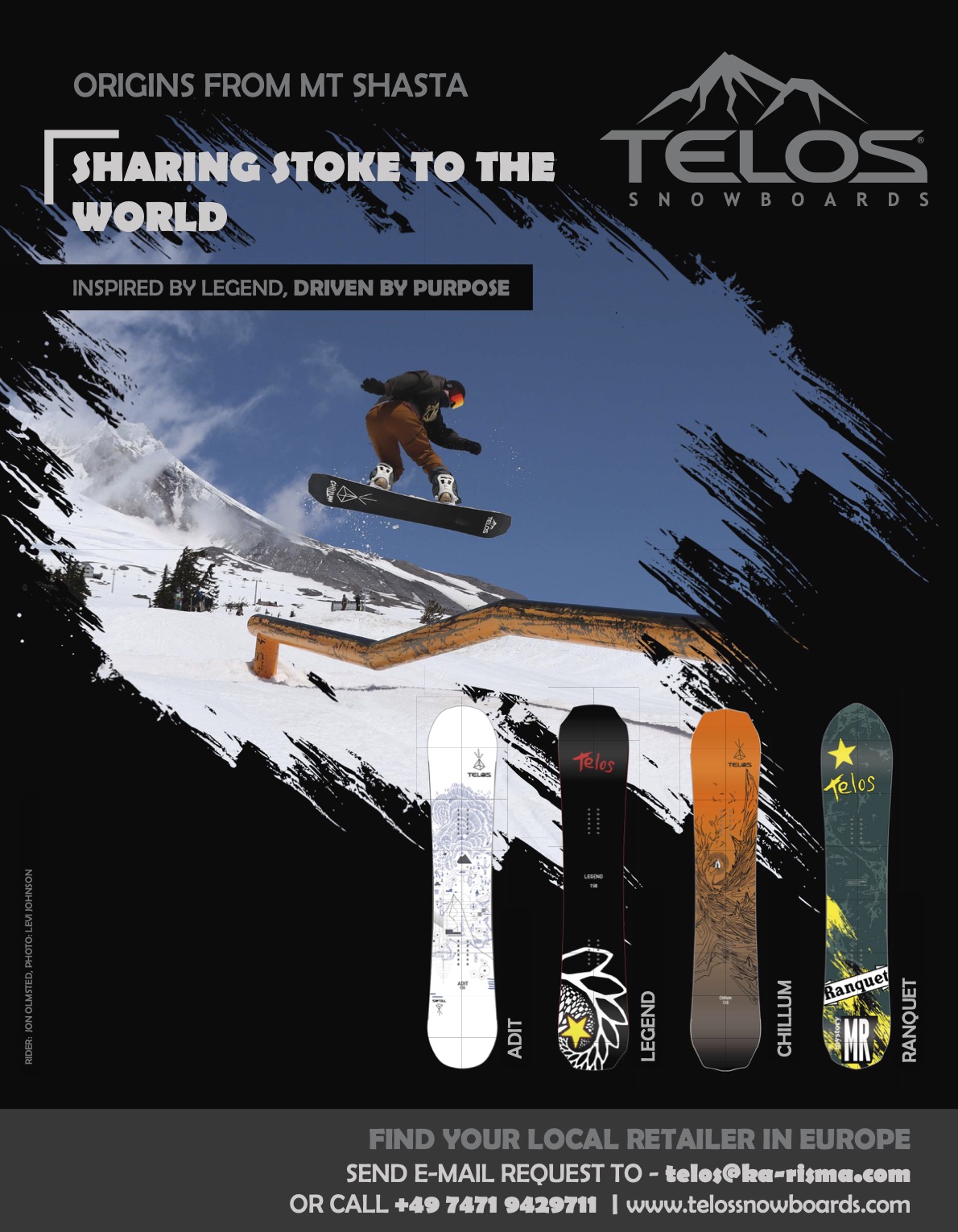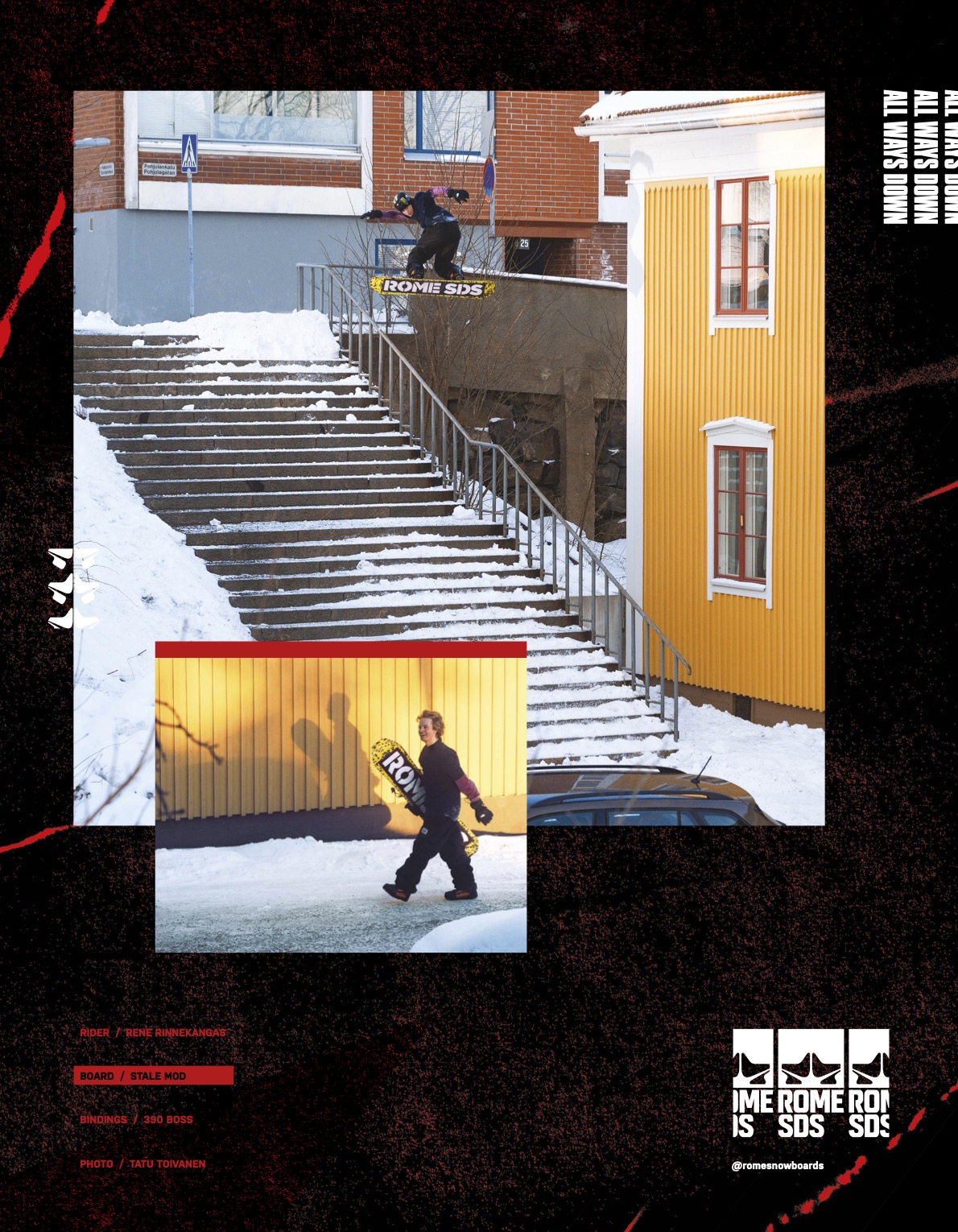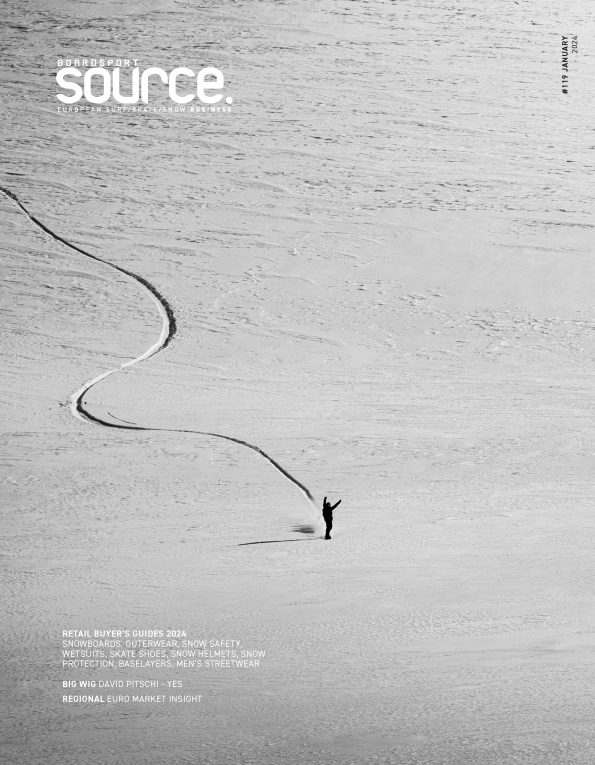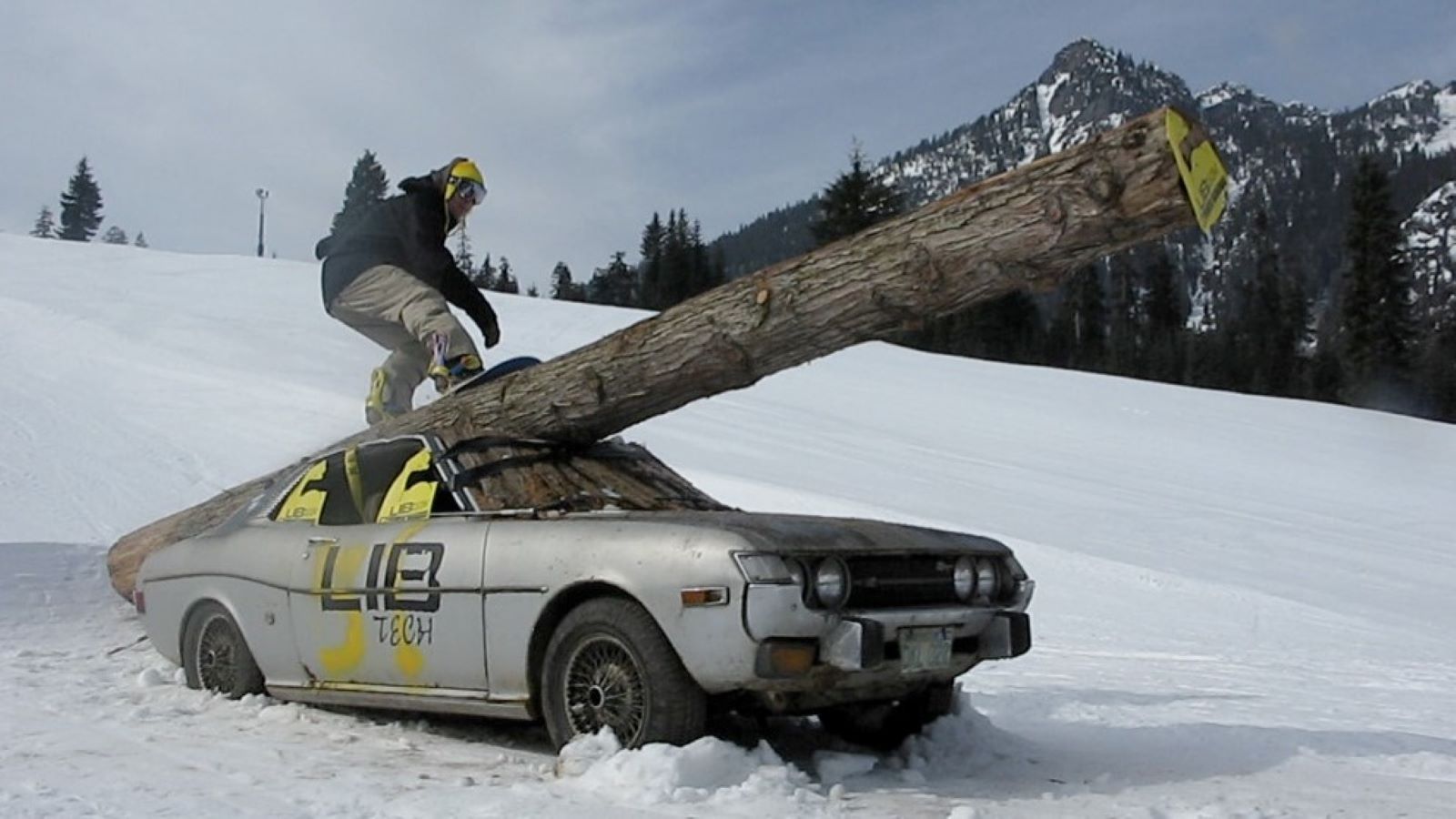
Big Wig: Mervin Manufacturing’s Pete Saari
We’re stoked to welcome Mervin Manufacturing Co-Founder Pete Saari to the Big Wig chair for Issue 110. Based in the Pacific Northwest of America, the company is one of the planet’s finest and most ecologically conscious board designers and manufacturers (spanning surf, snow & skate) and Pete talks to us about how he and Co-Founder Mike Olson met and how they’ve strived to build a company that they themselves enjoy working for. The photo credit for the header shot (above) goes to Annette Veihelmann.
Pete, tell us about your background in business and snowboarding.
I grew up skateboarding, skiing and surfing in Washington State, which is the NW corner of the USA just below Canada (snowboarding didn’t exist when I grew up). There were almost no other surfers around, especially young ones. In my teens, I ran into Mike Olson at the beach with our mutual friend Mervin. At the time, Mike was shaping surfboards for friends and had also been building snowboards, both as shop projects and for friends. Since there were no surf shops around back then, we were all making our own boards as that was the only way to get them.
In about 1984, I started snowboarding with Mike and our tight little crew. We’d both finished the first couple of years of college when Mike decided his snowboards worked a lot better than some of the others he’d checked out; as a result, he wanted to give making snowboards a go as his own business and needed someone to help him. I had always dreamt of being in the ski industry, so when he offered me a job as his “abrasive technician” doing all the dirty steps, I was all in. We both quit college and have been building boards full-time ever since.
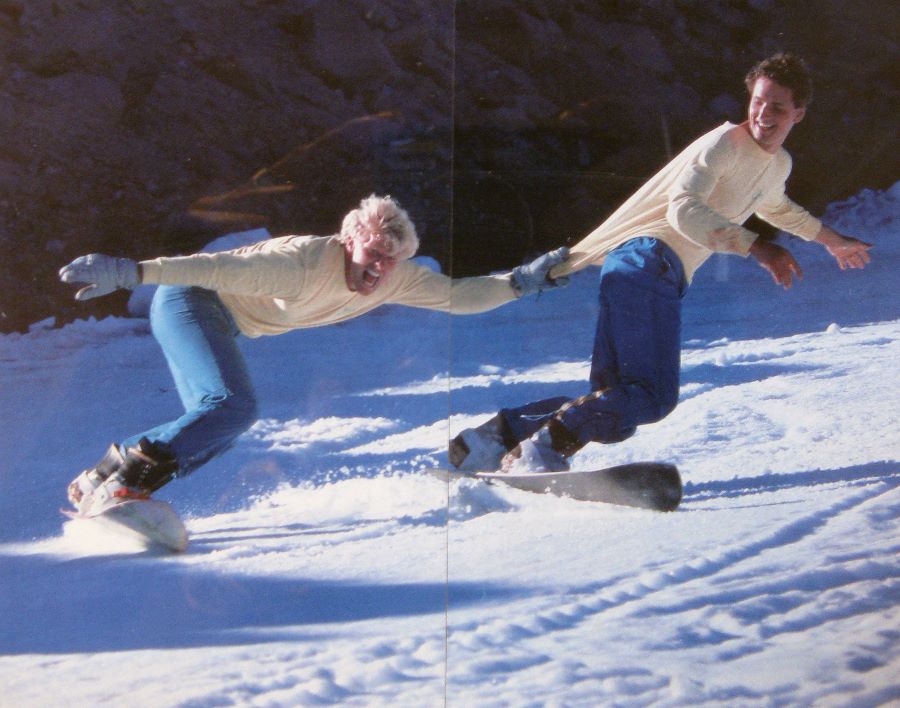
Mike and Pete, circa 1984. Photo by Scott Miller
How did you come to create Mervin?
I can’t do this interview without Mike Olson. He’s a technical genius. An obsessed creative artist who always thinks outside the box. He was going to make it in this world, no matter what he did. As I mentioned above, he gave me a lifesaving, dream opportunity that I just knew I had to take. We both love making boards and experimenting. Together, we built Mervin.
Mike and I grew up as passionate skiers and were inspired by Bobby Burns (of The Ski) and Mike Burnetto (who hand built skis in the 70s). We were also surrounded by the waterski industry, with people like Connelly and Denny Kidder, who were running their own waterski building business in our region. Boeing Aerospace was our hometown employer, so our region was home to a large composite engineering community. The Kirshner Brothers had their ski company ‘K2’ on Vashon Island, so we did have examples and heroes who showed us it was possible to be composite board builders. (Ironically we later designed K2’s first snowboard.)
From quitting school and dedicating all our energy to board building, step by step, year by year, it all eventually came together to create what is now known as Mervin. Mike had some early geometry concepts that basically defined the modern snowboard as you see it today. Deep progressive sidecuts, full width tips inspired by the ski shapes, cambers centred under the back foot so you could fully activate them. Those first geometry concepts put us at the forefront of bringing snowboarding to resorts: our boards carved amazing pin lines on hardpack when other boards were either powder focussed or skidding around and barely controllable in resort terrain. Our local resort, that had allowed us to ride for years, actually shut down snowboard access when the first Burtons with fins arrived and people couldn’t control them.
As we began to have a bit of success, we were able to buy all the tools we needed (or wanted!) to create the ultimate board building “kitchen”, something which has become the foundation of what makes Mervin, Mervin. Essentially, we have a toy making factory where we make high performance snowboards. Great boards attract great riders, like our first world champ, Amy Howat. Matt Cummins, an innovative skate-minded shredder, was our first Lib team rider and he still designs new boards for us every year. Other team riders have included: Jamie Lynn, Danny Kass, Barrett Christy, Temple, Cannon, Austen Sweetin, Eric Jackson, Phil Hansen, Jacob Wilhelmson, James Stentiford, Travis Rice, Jamie Anderson, Naima Antolin, Forest Bailey, Blake Paul, the Worbingtons and many more amazing shredders over the years.
Our production process has evolved from our R&D prototype system, a system which allows us to easily experiment with all aspects of design. The creative freedom this provides inspires us, and our ExperiMental Division crew, to think outside the box. Any ideas can be built and tested quickly without cost challenges. It’s this creative freedom that’s attracted some great people to Mervin, including myself, our Head Production Engineer Steven Cobb (who had previously worked with Mike), and our athletes to name a few. Together, we’ve worked on all kinds of fun design projects over the years. Even after 3 decades of board building, there’s still nothing more exciting than getting a new shape or design concept on a hill and seeing how it goes.
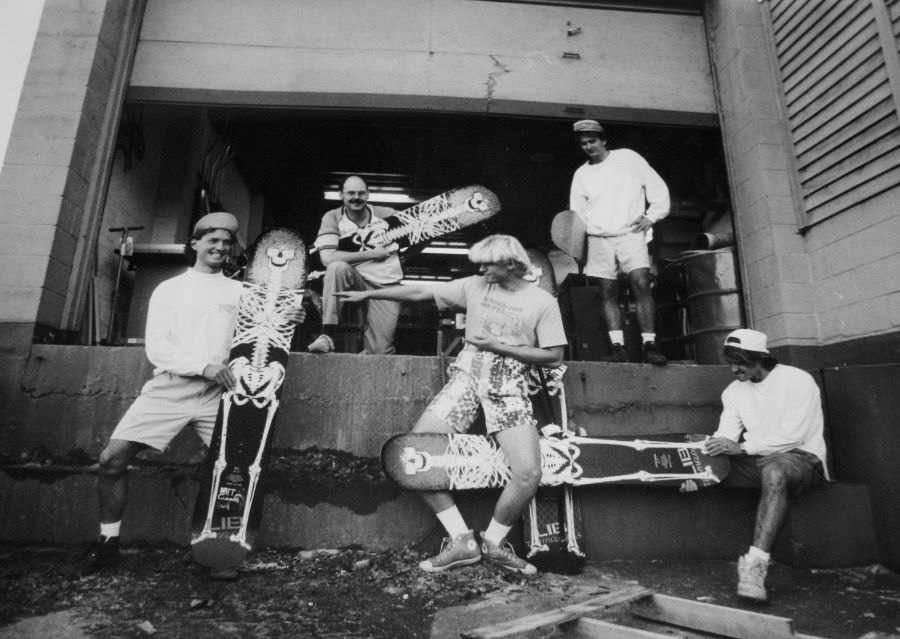
Mervin, circa 1988. Photo by Chris Brunkhart
What are the top 3 achievements in your career?
Just being able to run an idealistic factory/company that has sticked to its principles for all these years has been something of a miracle. Mike and I always felt like we would work smarter than anyone else and if that didn’t work, we would work harder. It’s been a lot of fun and a heck of a lot of work keeping things going through various economic climates and eras.
I think what matters to me the most is the relationships we have with our crew, our riders and industry folks that we have been fortunate enough to work with over the years. We have such a great team internally, who all excel in their own way and all love to shred. I love them all.
In terms of technical accomplishments, we have brought quite a few innovative ideas and concepts to snowboarding, and oddly enough, this includes introducing camber in the early 80s and, a decade later, the re-introduction of hybrid rocker/camber contours. Magne Traction® serrated edges is another fun concept we were able to introduce to snowboards and skis. This concept is still very much developing.
What have been the biggest lessons learnt in the past 18 months?
The past 18 months have been interesting… the first thing I had to relearn is not to panic… study the world around you so you are aware of what’s going on but also, to remember to live in the moment. One day at a time. If you feel like the world is crumbling around you, take a deep breath and step outside into nature… usually everything is just fine. In fact, it’s lovely. I self-medicate with skateboarding, biking, surfing, and when the snow falls, sliding on just about every snow toy we can build or find… injecting a little bit of risk into your life forces you to focus and be in the moment… it becomes mediation. Also, I’ve learned to take nothing for granted, every day is a gift and so are the people around you (well…most of them 😉).
The pandemic has created so many challenges, but I just try and focus on the gifts. I spend half of the day working from home, so I get more time with my kids. My schedule is a bit more flexible nowadays, so if the surf is good, I can get at it during lunch and still get all my work done seamlessly. As I’m writing this, I’ve just got in from a snowboarding session with the kids. Before the pandemic, my work schedule was a lot more rigid, so the new flexibility has been magical for me and my family.
Could you please talk to us about your predictions for the future of retail and ecommerce in the snowboard industry?
We are really committed to working with retailers. There is something special about a surf or snow shop and getting to talk with knowledgeable and passionate people that love shredding and know their gear. I grew up crawling around on the floor of the original REI in Seattle, back when it was a one-stop mountaineering shop. I’ve got the smells of boot sealer, sleeping bags and camping gear imprinted on me. I hope the economic climate will always allow good retailers to thrive. Many have a balance between online and brick and mortar. I feel like variations of that kind of hybrid setup is going to be a formula that works going forward. I am a gear nerd, so I like to touch and feel what I buy especially when it comes to boards, boots, bindings etc… I also love the comradery and friendships that build around local shops. The current pandemic climate makes being instore challenging, but this will pass eventually, and we will return to some sort of new normal that will allow us to be together again. Perhaps Omicron will be a blessing in some way and set up a solid herd immunity that facilitates humans gathering again. In the meantime, online is an option that works when we have restrictions in place.
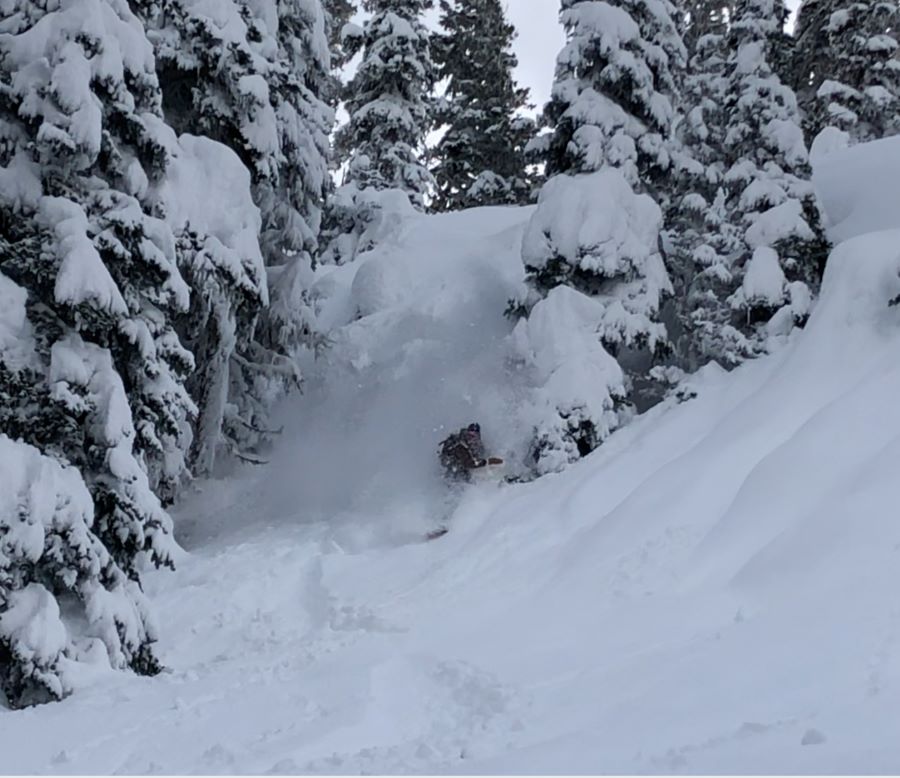
What B2B software are Mervin using and how has it improved customer service for B2B and B2C?
We use Hubsoft. We are a manufacturer; we build to fill prebooked orders which really helps us plan and map our year. We always build a small percentage of sales straight away. These early orders and builds are based on B2B forecasts from our sales team, to give our dealers an insight into what we have available, a shop window if you will. Our dealers always get first look in. The shops that take advantage of this opportunity love it and usually take almost everything we build. If our retailers don’t want it, we shift it to our own online store; we don’t build inventory specifically for our online business.
What was the thinking behind the diversification into surf and skate?
We love surfing and skating and have been building skate and surf boards for ourselves all our lives. We didn’t want to enter those worlds from a business perspective unless we had something exciting to bring to them. Traditional surfboards are so fragile, and the building process is so toxic, that we decided we wanted to build boards with a longer lifespan and were much more environmentally friendly. Developing our surf construction process was a huge undertaking. A process led by our very own Mike Olson.
Making one environmentally friendly board is fairly easy but developing a whole new process that allowed us to build cost-effective boards at our factory in the USA took us 10 years. We’re constantly improving our surfboards. The newest version of our board is lighter whilst still being just as strong and environmentally friendly. It’s pretty exciting!
With our skateboards, we were focussed on improving durability. People break so many skate decks. If you’re skating a lot, a traditional deck lasts roughly 2 weeks. Under heavy use, ours will keep their pop for around 3 months. They last a year for me… but then again, I’m an old dude. For the past year, skate has taken a bit of a backseat as we’ve had to focus on our core business, but skate will always be something we do. Surf gives our business more balance, providing different peak season cycles. The best surf is usually in the winter when the snow business is firing, but peak selling seasons for surf is in the spring/summer.
Which eco achievements are you most proud of with your production facility?
Mike and I have always been very conscious of making sure Mervin is a safe and healthy place for people to work. We spent most of our lives on the factory floor and wanted it to be a healthy environment for ourselves, then when we started hiring friends, it became even more important to ensure processes and material decisions were safe.
We started Mervin with passion and ideas but very little money, therefore efficiency with materials was paramount and still remains part of our formula. We try to minimise waste as much as possible. Building in the USA is a challenge cost wise, so we’ve always focussed on ensuring our process being as technologically advanced as possible while remaining simple and efficient to keep labour costs down. Our eco-sublimation system was a huge one for us as printing is usually one of the most toxic aspects of ski and snowboard building. Lots of smelly solvents are used, many are linked to causing cancer. Our process is one we developed ourselves and uses a unique combination of water-based inks, heat and pressure. Developing this process was a big breakthrough for us which made it possible to have the kind of work environment we wanted, from the start of the building process to the end.
Our ‘Sawdust to Soil’ wood dust recycling program is a fun one. We take all the dust from our core shop and donate it to a local soil company that composts it into soil for residential and commercial use. On the surf side of business, our entire process is pretty amazing; it’s completely unique and has many environmental components. The first of which is a longer board life, however it’s the materials and building process that’s the exciting part. We use a plant-based resin, our foam uses a non-ozone depleting blowing agent, we have eliminated most of the sanding steps and our process radically minimises any exposure to resin and uses no solvents. We compact all of our foam dust and are able to send it back to our core manufacturer to make more blanks.
How does a snowboard company sustainably grow year on year?
That’s an interesting question. Manufacturing and just being alive leaves an environmental footprint. We are doing a lot of things to minimise Mervin’s environmental impact and hopefully inspire others to do what they can. Patagonia is one of the companies that inspired us. There is a certain point where our factory capacity maxes out, from which we will have to make some decisions on scale. For now, we have diversified into surf and tried to bring something environmentally significant to that world. There are still some steps in our snowboard building process that we can improve on. We have produced zero hazardous waste for years and our next goal is to reach zero waste being dumped in landfill, instead, we aim to have all of our waste either recycled, composted or made into other products downstream. There are some front-end costs, in both time and money, that we need to work through, but overall, this goal is another exciting step for us. I think the answer is always going to be that the bigger you are, the larger environmental footprint you have on the planet… but we are constantly working to be better and improve our little toy factory.




